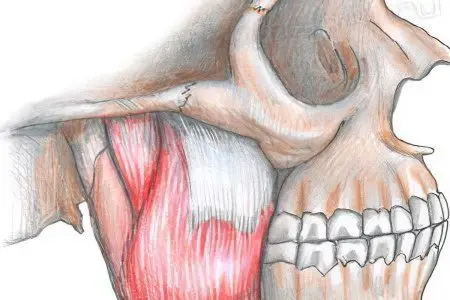Contents
Causes and symptoms of facial muscle atrophy

Atrophy of the muscles of the face is a fairly rare disease that occurs mostly in women and most often in adolescence or childhood. The causes of the onset and development of the disease have not yet been sufficiently studied, but it is believed that this is one of the forms of scleroderma that has developed as a result of a traumatic or infectious lesion of the trigeminal nerve or the autonomic nervous system, a dysfunction of the endocrine glands.
Causes of facial muscle atrophy
The disease is manifested by the gradual development and progression of atrophy of subcutaneous fat, muscle tissue and skeletal bones, mainly of one half of the face. Bilateral atrophy is very rare.
It should be noted that in most cases, progressive atrophy of the muscles of the face is a syndrome of various diseases associated with disorders of the autonomic nervous system. It can be assumed that injuries and diseases are only an impetus for the development of neurodystrophic changes.
Progressive atrophy of the muscles of the face is characterized by a gradual, slow development of asymmetry, the discrepancy between the right and left halves becomes quite noticeable, the ratio of the volume of the facial part of the skull and soft tissues gradually increases. The left side of the face is more commonly affected. Not only soft tissues undergo pathological changes, but also the bones of the facial skeleton on the side of the lesion. The subcutaneous fat becomes thinner to the thickness of parchment paper, the skin gathers into many folds during a smile, depigmentation of the skin of the face from gray to brown is observed, the work of the sebaceous glands is disrupted, eyelashes and eyebrows may fall out, carious syndrome develops. After that, muscle tissue is affected, especially chewing and temporal, bone tissue. Retraction of the infraorbital region is often observed with atrophy of the upper jaw.
The disease, as a rule, begins with one half of the face and, as it develops, moves to nearby tissues, sometimes to the other half and to the muscles of the neck and trunk.
Symptoms of facial muscle atrophy

At the very initial stage of the development of facial muscle atrophy, when there are no obvious clinical manifestations yet, the healthy side is sometimes mistaken for the diseased side, considering it to be swollen. The so-called myopathic face is formed with a characteristic specific appearance: a smooth forehead, not completely closed palpebral fissures and inactive thick lips. It is very difficult for the patient to close his lips into a tube, whistle, blow out a candle. If a person smiles, then the corners of his mouth diverge in different directions.
Pain syndrome for a progressive form of the disease is uncharacteristic. At times, a person may feel a tingling sensation in the affected part of the cheek or face. Quite rarely there is tearing of the eyes in the cold and in the wind. There is a very significant difference in the color of the cheeks, especially in the cold – one gets the feeling that one side of the face belongs to a person exhausted by a serious illness, and the other is completely healthy. The skin on the affected side becomes yellowish-gray or brown and does not develop a blush. As a result of the retraction of the lower eyelid, the palpebral fissure expands. With pressure in the eye area and chin area, pain occurs. The chin is shifted towards the affected side of the face.
Most often, the sensitivity of the muscles of the face is preserved, but sometimes there are paresthesias and characteristic neurological pains along the facial branch of the trigeminal nerve. The function of the muscles, despite their thinning, is not disturbed. As a complication of the disease, paralysis of the facial, lingual, eye muscles and muscles of the soft palate can develop.
Atrophy of the muscle tissue of the face can stop spontaneously, reaching a certain degree of development, sometimes even very severe. The process stops and no longer progresses. At this stage, plastic surgery can be applied.
Diagnosis and treatment of facial muscle atrophy
The diagnosis is established on the basis of the clinical picture and the collection of an anamnesis of the disease. Differential diagnosis is carried out with congenital disorders of the facial structure. In all forms of progressive atrophy of the muscles of the face, variously pronounced dysfunctions of the autonomic nervous system were noted. It is almost impossible to stop or cure the disease with various medications, physiotherapeutic methods, surgical interventions, they do not have the desired effect.
Sometimes plastic surgery of existing eye drops is performed by transplanting subcutaneous fat taken from the thigh. General strengthening and stimulating therapy is carried out, a vitamin complex is prescribed. Restoration of the anatomical shape of the face is carried out only after the stabilization of the process.
[Video] How to treat muscle atrophy:









